Epsp Study guides, Revision notes & Summaries
Looking for the best study guides, study notes and summaries about Epsp? On this page you'll find 235 study documents about Epsp.
All 235 results
Sort by
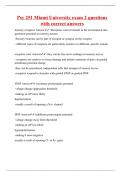
-
Psy 251 Miami University exam 2 questions with correct answers
- Exam (elaborations) • 17 pages • 2023
-
- £10.97
- 1x sold
- + learn more
Sensory receptors Answer -Receptors convert stimuli in the environment into generator potential on sensory neuron -Sensory Neurons can be part of receptor or synapse on the receptor - different types of receptors are particularly sensitive to different, specific stimuli receptors cont. Answer -they can be free nerve endings on sensory nerves - receptors are sensitive to tissue damage and initiate sensation of pain via graded membrane potential charge -they can be specialized, independent...
EPSP SCON 361 TEST WITH COMPLETE SOLUTION...
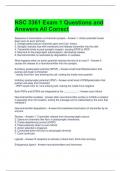
-
NSC 3361 Exam 1 Questions and Answers All Correct
- Exam (elaborations) • 14 pages • 2024
- Available in package deal
-
- £10.19
- + learn more
NSC 3361 Exam 1 Questions and Answers All Correct Sequence of transmission at chemical synapse - Answer-1. Action potential travels down axon to axon terminal. 2. Voltage-gated calcium channels open and Ca2+ enters. 3. Synaptic vesicles fuse with membrane and release transmitter into the cleft. 4. Transmitter binds to post-synaptic receptor, causing EPSP or IPSP. 5. May bind to the presynaptic autoreceptors, decreasing release. 6. Neurotransmitter is inactivated by degradation or reuptak...
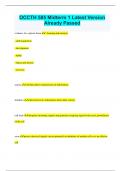
-
OCCTH 585 Midterm 1 Latest Version Already Passed
- Exam (elaborations) • 50 pages • 2024
- Available in package deal
-
- £9.40
- + learn more
OCCTH 585 Midterm 1 Latest Version Already Passed evidence for a plastic brain - learning and memory - skill acquisition - development - aging - injury and disease - recovery neuron cell that allows transmission of information dendrites collects/receives information from other sources cell body integrates incoming signals and generates outgoing signal to the axon; powerhouse of the cell axon passes electrical signals (action potential) to dendrites of another cell or to...
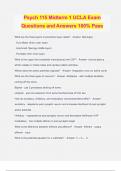
-
Psych 115 Midterm 1 UCLA Exam Questions and Answers 100% Pass
- Exam (elaborations) • 23 pages • 2024
- Available in package deal
-
- £9.80
- + learn more
Psych 115 Midterm 1 UCLA Exam Questions and Answers 100% Pass What are the three layers of protective layer called? - Answer- Meninges - Dura Mater (thick outer layer) - Arachnoid (Spongy middle layer) - Pia Mater (thin inner layer) What is the organ that constantly manufactures the CSF? - Answer- choroid plexus, which resides in hollow tubes and cavities called ventricles Where does the action potential originate? - Answer- Integration zone (or active zone) What are the three types of ...
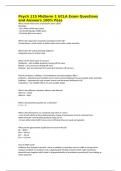
-
Psych 115 Midterm 1 UCLA Exam Questions and Answers 100% Pass
- Exam (elaborations) • 13 pages • 2024
-
- £8.38
- + learn more
Psych 115 Midterm 1 UCLA Exam Questions and Answers 100% Pass What are the three layers of protective layer called? Meninges - Dura Mater (thick outer layer) - Arachnoid (Spongy middle layer) - Pia Mater (thin inner layer) What is the organ that constantly manufactures the CSF? choroid plexus, which resides in hollow tubes and cavities called ventricles Where does the action potential originate? Integration zone (or active zone) What are the three types of neurons? Multipo...
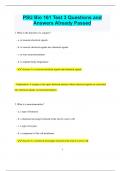
-
PSU Bio 161 Test 3 Questions and Answers Already Passed
- Exam (elaborations) • 11 pages • 2024
- Available in package deal
-
- £7.84
- + learn more
PSU Bio 161 Test 3 Questions and Answers Already Passed 1. What is the function of a synapse? - a. to transmit electrical signals - b. to convert electrical signals into chemical signals - c. to store neurotransmitters - d. to regulate body temperature - Answer: b. to convert electrical signals into chemical signals Explanation: A synapse is the space between neurons where electrical signals are converted into chemical signals via neurotransmitters. 2. What is a neurotransmitt...
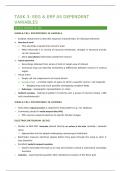
-
Task 3 - EEG & ERP as dependent variables
- Summary • 13 pages • 2024 Popular
- Available in package deal
-
- £3.47
- 1x sold
- + learn more
Summary of Task 3 of Methods of Cognitive Neuroscience
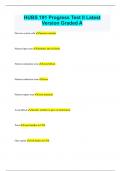
-
HUBS 191 Progress Test II Latest Version Graded A
- Exam (elaborations) • 34 pages • 2024
- Available in package deal
-
- £7.84
- + learn more
HUBS 191 Progress Test II Latest Version Graded A Nervous system cells neurons and glia Neuron input zone dendrites and cell body Neuron summation zone axon hillock Neuron conduction zone axon Neuron output zone axon terminals Axon hillock decides whether to pass on information Tract axon bundles in CNS Grey matter cell bodies in CNS White matter myelinated axons in CNS; commissural, projection, and association tracts Ganglion groups of cell bodies in PNS Nerv...
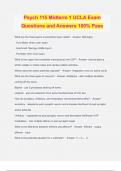
-
Psych 115 Midterm 1 UCLA Exam Questions and Answers 100% Pass
- Exam (elaborations) • 23 pages • 2024
- Available in package deal
-
- £9.80
- + learn more
Psych 115 Midterm 1 UCLA Exam Questions and Answers 100% Pass What are the three layers of protective layer called? - Answer- Meninges - Dura Mater (thick outer layer) - Arachnoid (Spongy middle layer) - Pia Mater (thin inner layer) What is the organ that constantly manufactures the CSF? - Answer- choroid plexus, which resides in hollow tubes and cavities called ventricles Where does the action potential originate? - Answer- Integration zone (or active zone) What are the three types of ...

How did he do that? By selling his revision notes on Stuvia. Try it yourself! Discover all about earning on Stuvia



